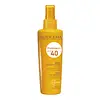What's inside
What's inside
 Key Ingredients
Key Ingredients

 Benefits
Benefits

 Concerns
Concerns

 Ingredients Side-by-side
Ingredients Side-by-side

Octocrylene 8%
UV AbsorberMethylene Bis-Benzotriazolyl Tetramethylbutylphenol 6%
UV FilterButyl Methoxydibenzoylmethane 5%
UV AbsorberWater
Skin ConditioningDicaprylyl Carbonate
EmollientAlcohol Denat.
AntimicrobialHydroxypropyl Dimethicone Behenate
Skin ConditioningDecyl Glucoside
CleansingC20-22 Alkyl Phosphate
EmulsifyingC20-22 Alcohols
Emulsion StabilisingTocopheryl Acetate
AntioxidantPhenoxyethanol
PreservativeXanthan Gum
EmulsifyingMethylparaben
PreservativeParfum
MaskingDisodium EDTA
Propylparaben
PreservativeEthylparaben
PreservativeSodium Hydroxide
BufferingMannitol
HumectantXylitol
HumectantPropylene Glycol
HumectantCitric Acid
BufferingEctoin
Skin ConditioningFructooligosaccharides
HumectantCaprylic/Capric Triglyceride
MaskingRhamnose
HumectantLaminaria Ochroleuca Extract
Skin ConditioningOctocrylene 8%, Methylene Bis-Benzotriazolyl Tetramethylbutylphenol 6%, Butyl Methoxydibenzoylmethane 5%, Water, Dicaprylyl Carbonate, Alcohol Denat., Hydroxypropyl Dimethicone Behenate, Decyl Glucoside, C20-22 Alkyl Phosphate, C20-22 Alcohols, Tocopheryl Acetate, Phenoxyethanol, Xanthan Gum, Methylparaben, Parfum, Disodium EDTA, Propylparaben, Ethylparaben, Sodium Hydroxide, Mannitol, Xylitol, Propylene Glycol, Citric Acid, Ectoin, Fructooligosaccharides, Caprylic/Capric Triglyceride, Rhamnose, Laminaria Ochroleuca Extract
Ingredients Explained
These ingredients are found in both products.
Ingredients higher up in an ingredient list are typically present in a larger amount.
This ingredient is an emollient, solvent, and texture enhancer. It is considered a skin-softener by helping the skin prevent moisture loss.
It helps thicken a product's formula and makes it easier to spread by dissolving clumping compounds.
Caprylic Triglyceride is made by combining glycerin with coconut oil, forming a clear liquid.
While there is an assumption Caprylic Triglyceride can clog pores due to it being derived from coconut oil, there is no research supporting this.
Learn more about Caprylic/Capric TriglycerideDicaprylyl Carbonate comes from carbonic acid and caprylyl alcohol, a fatty alcohol. It is an emollient and gives skin a velvet feel. The sources of Dicaprylyl Carbonate may be synthetic or from animals.
As an emollient, Dicaprylyl Carbonate creates a film on the skin. This film traps moisture in, keeping your skin soft and hydrated.
Tocopheryl Acetate is AKA Vitamin E. It is an antioxidant and protects your skin from free radicals. Free radicals damage the skin by breaking down collagen.
One study found using Tocopheryl Acetate with Vitamin C decreased the number of sunburned cells.
Tocopheryl Acetate is commonly found in both skincare and dietary supplements.
Learn more about Tocopheryl Acetate